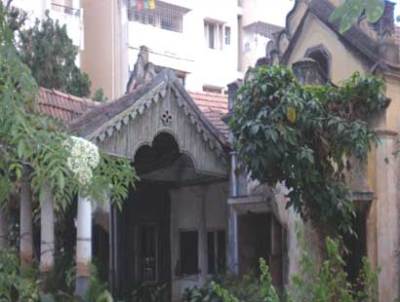>
It was around this time, in the late seventies ( 1977 ) that Mrs Janet Pott painstakingly compiled and wrote ` Old Bungalows in Bangalore ‘, in collaboration with her daughter, our wonderful family friend, Elizabeth Staley and Romola Chatterjee who was the daughter of Srirangam Desikacher Seshadri Iyengar, a hydro-electric engineer, graduate of Columbia University, New York ( 1919) and Chief Electrical Engineer, Sivasamudram.
The book is a valuable reference for the domestic architecture of the 19th and 20th centuries in Bangalore. It had photographs of bungalows, plans, drawings and sketches of architectural details that might have crept by unnoticed, except to the trained eye. For years I imagined that we had the only existing copy, till I discovered, to my delight, that you can now order it off Amazon.com ! In it Mrs. Pott says ‘ …the pleasant, spacious layout ( of the city) still remains and it is still an attractive place to live in “. Alas. If one could fast forward to thirty years hence, it would be a story of despair and disillusionment.
 |
| Traditional Monkey Top style |
Urban legend has it that they were built to ward off monkeys but this may not be so, as there seems to have been plenty of space for the marauders to sit and devour fruits anyway ! I have childhood memories of many wars waged against monkey armies who were not heroes from Indian mythology but rather, greedy little fellows hell bent on demolishing my grandmother’s avocados in one sitting.
 |
| Monkey Top slat details |
Richmond Town still posesses a few, tucked away in odd corners of leafy bylanes and so does Langford Town. Across Bangalore, you will still find some hidden off Commercial Street, Shivajinagar, Frazer Town, and of course, the fabulously well preserved jewel in the Taj Group crown, the Taj West End Hotel, a glorious ode to conservation. Families still live in here but the cost of maintenance is high and it is tempting to sell out or convert the space into a fancy retail outlet or restaurant. Elegant history seems to be no match for brazen commerce which currently rules the city.
Not so long ago, these bungalows along with the traditional architecture in South Bangalore ( Basavanagudi area ) and the fifties style Art-Deco buildings that came later gave Bangalore a clear architectural identity. Today the city sits swathed in anonymity as it morphs into a concrete jungle devoid of beauty and inspiration.
 |
| Window and more slat details |
If you decide to set forth on your own Monkey Top Trail, make sure you take along a fine tooth comb and a keen eye. I take along my camera as well and risk being chased by pedigreed dogs, looked upon suspiciously by watchmen and shouted at every once in a while for trespassing. But who cares ? If one is lucky one just might turn a corner and chance upon a little bungalow quietly crumbling away in the shadow of an ugly apartment complex.
When you find one, hold on to the view and tuck it into your heart for one day it too will die. A lingering, exhausted victim of the dreaded malaise that swept through Bangalore in the 90’s and never left us – the malignant disease called `indifference to heritage-itis’. The aftermath of the epidemic has left us architecturally anaesthetised – with very little to offer the future, except for floatglass citadels.



Great read. I live near Frazer Town and everytime I pass by one of these old houses I stop for a moment and quietly wonder if they’d let me in and tell me stories and perhaps share a few pictures from yesteryear with me. I love these old crumbling buildings. Your last paragraph made me quite sad 😦
Mos, you should stop and let yourself in.The greatest part of being a Bangalorean was how much time people had for each other and how we connected.They would hopefully tell you stories you could then tell me!:-)
hey, wonderful….I met Elizabeth and Romola in 1981…..and then in 1992/3 came across Elizabeth , living across the road from friends of mine in Hertfordshire…!!!!!
Patrick, this is so amazing because I grew up with Elizabeth, John and the children, they lived two houses away and I owe her so much.
I stay in one of those British Bungalows on St.john’s Hill, other side of the old Dewar’s bar. Now the Bungalow looks different with my uncle demolished half of the building, it saddens me to see these bungalows disappear slowly, but we are glad to retain whatever bit is left. I was hoping to see if the book has more details or photos about my bungalow, it was called “the Priory” made in 1904, used as a rest house for British Cavalry! 🙂
Mr. Kumar, thank you for writing in.Would you mind if we took pictures of your house for our archives?
I missed your reply somehow. What stands today is 50% of the property (after partition). We want to renovate the place and the designs/plan in this book will help retaining the structure..
After the renovation, I would gladly invite you to our place. You can still drop in, search for Wolabi solutions on Google maps.
Very informative…Being an architecture student, I’m really interested about the monkey tops and the old Bangalore style houses. Would like to know more and study about it.